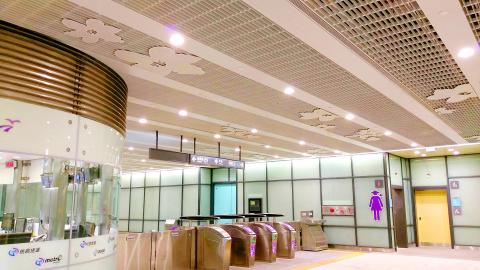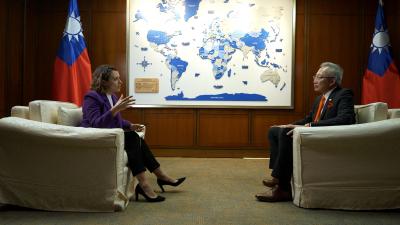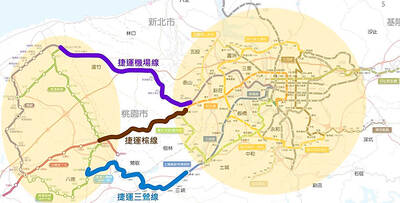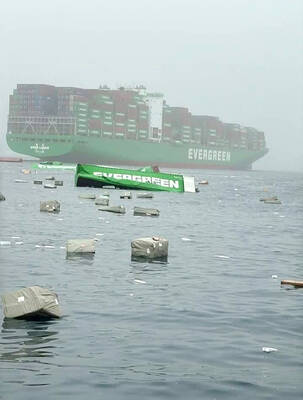Liberty Times (LT): About NT$113.8 billion (US$3.53 billion) has been spent on the Taiwan Taoyuan International Airport Mass Rapid Transit (MRT) system, which has been marred by controversy, including six missed deadlines. Where do you think the crux of the problem lies?
Cheng Wen-tsan (鄭文燦): Work on the planning stage of the airport MRT began as early as 1996 when it was decided that it would be built as a build-operate-transfer (BOT) project, with Ever Transit International Co (長生國際開發) winning the contract bid. Financing problems resulted in constant delays, and in 2002, the Bureau of High Speed Rail ended its relationship with Ever Transit, turning the system into a publicly funded project.
The Legislative Yuan then contracted work out to the bidder with the lowest cost proposal, with Japan’s Marubeni Corp and Kawasaki Heavy Industries winning a joint bid for the project.

Photo courtesy of Taoyuan Metro Corporation
After construction began in 2006, the section of track between Sanchong Station and Taipei Main Station was changed to an underground track, pushing back the estimated time of completion. Adding to this, the cost of materials and property increased and initial cost estimates caused incessant disputes between Marubeni and its subcontractors.
There were problems with the quality of the signaling system and this delayed progress on network testing. This, combined with substandard construction materials, resulted in the six delays.
Marubeni’s contract with the bureau was found to be illegal and a fine of NT$2.5 billion was imposed.
After I took office I learned of all the problems marring the project and realized we were not able to immediately solve them. The greatest responsibility lies with Marubeni, who won the contract with the lowest-cost bid, but along with its subcontractors produced a sub-par system. The bureau, which was supposed to be supervising the project, as well as Sinotech Engineering consultants, who were supposed to be overlooking construction, are also responsible for the delays.
LT: Have appropriate solutions to these disputes been found?
Cheng: The bureau since 2013 has known that operations would be delayed, as the overall network tests, pre-revenue service running tests and stability tests together produced 4,822 anomalies since that time. By November 2015, the system was still only running at 70 percent operational readiness, which in practical terms means six hours of delays out of a day’s 19 hours of operation.
Then-premier Mao Chi-kuo (毛治國) suggested to the Ministry of Transportation and Communications that the system be put into operation with a reduced number of trains running at lower speed, but to do so would have meant lowering standards and helping contractors cover up their errors. The city government’s hands were tied, all I could do was criticize the ministry for helping the contractors hide their mess and handing a crippled network to the city — this is very irresponsible.
Previous systems tests revealed three core problems with the airport MRT.
The first was that the signaling system would randomly go offline leaving the control room with no way to determine a train’s location — the train would become a ‘ghost train.’ When that happens an emergency braking system is engaged to prevent the possibility of collisions.
The second core problem was that from 2011 until last year the steel wheels have not been regularly grinding against tracks as you would see with operational trains, so the wheels are misshapen. The trains have also accumulated residue from lack of use and high levels of humidity, meaning that trains are unable to stop when entering stations.
The third problem was that an insulating spacer between the tracks and the foundation underneath was cracked in more than 6,000 places, with areas around corners especially affected. This resulted in signaling system failure, as well as affecting the spacer’s ability to absorb vibrations.
With the transition of government in May last year, the ministry established a committee tasked with supervising progress on the airport MRT, formed by officials from the Taoyuan City Government and representatives from Marubeni and Siemens, the main subcontractor.
The four began on-site inspections with the city acting as the supervising body at their request. The Taoyuan Metro assumed management of the 21 stations on the line, the train depot, the cars and the line’s central control room. The city government also sent representatives to Siemens to talk about the project and bring Siemens engineers to Taiwan and assist with signaling problems. These three core problems have largely been solved.
LT: When the Chinese Nationalist Party (KMT) was in office there was a lot of criticism directed at the airport by the pan-green camp. Now with a change in government it looks like the line will finally be given the green light this year. How do you answer accusations of partisanship?
Cheng: The line should have become operational in 2014. During the KMT administration there were two points in time where there was hope for launching operations on the line. The first was at the end of 2015 during the presidential elections. The second was in May last year, just before former president Ma Ying-jeou (馬英九) stepped down. There was the hope that it would be one of the legacies of Ma’s administration.
I certainly did not oppose the opening of the line on grounds of it being during Ma’s presidency, it was a choice made based on safety concerns, as the line had not yet met safety standards. The line was far from the 99 percent operational safety standard required by the Mass Rapid Transit Act (大眾捷運法). Beginning line operations is a decision made based on science. It is a professional issue that has nothing to do with politics.
Due to a lack of trust between the KMT and the Democratic Progressive Party (DPP), I met with former minister of transportation and communications Chen Jian-yu (陳建宇) on two occasions and signed a memorandum stating that I would not allow the line to operate until safety issues were resolved.
The memorandum also said that Taoyuan Metro would be reasonably compensated for financial losses incurred due to the delay in the line’s opening. After this, things proceeded smoothly.
Before that the KMT suspected the DPP of intentionally postponing line operations, while the DPP suspected the KMT of deceiving the public about safety concerns to have the line opened during Ma’s tenure. The two sides could not see eye-to-eye.
However, after the new government took office, the bureau and the city began working together and the problems were fixed one by one. We have finally achieved 99 percent operational usability.
LT: Reflecting on your experience with the airport MRT, what advice would you have for projects of this magnitude?
Cheng: I feel that large engineering projects should not be contracted to the lowest bidder.
Hiring such contractors will give rise to sloppy work, the use of shoddy materials and poor quality engineering. Work should be contracted to the most favorable bidder, to a company that is transparent, a company whose qualifications stand up to rigorous scrutiny. In this way there will not be suspicions of collusion and no need for subsequent bargaining, and it will be possible to avoid malpractice.
Companies like Germany’s Siemens and France’s Alstom that were competing with Marubeni for the bid were asking for about NT$2 billion more, but they came with highly competitive qualifications.
Conversely, lower-cost Marubeni used the wrong spacers under the tracks, and used low-grade electrical cabling and improper installation methods. Consequently there was fusion of the cables at 97 locations along the line. Other materials we found throughout the system were also of poor quality and were replaced after we discovered them.
We also have compliance management issues in dealing with international companies.
The government relies on supervision by professional construction management authorities, but they can only rely on supervision from manufacturers and cannot comprehensively supervise the project. This is one area of engineering that needs to be revolutionized.
Furthermore, if the construction team and the operators of the MRT are different companies, it is almost unavoidable that the two sides will be distrustful of each other.
I advise the government to establish a national engineering ministry that can fully take charge of MRT system projects. Just look at how New Taipei City established the Department of Rapid Transit Systems to build its own MRT stations, rather than allowing the Taipei City Government to handle the work. Having no projects to work on the Taipei City Government got permission to build the Taichung MRT system. Now we have separate MRT systems operating in Taipei, New Taipei City and Taoyuan. This is really strange. The system is bound to encounter problems.
LT: What will the opening of the airport MRT line mean for Taiwan’s development?
Cheng: The airport MRT line is 51km long. Aside from making that journey more convenient, the line will connect the three municipalities, bringing them within one hour of each other. And because the line will have stops for public gymnasiums, a branch of Chang Gung Memorial Hospital and Taoyuan and Taipei Taiwan High-Speed Rail stations, it will ease the pressure on the 9 million residents served by the metro. It will also be instrumental in spurring development of real estate and growth in the industrial zones. Specifically, the line will connect the New Taipei Industrial Park at station A3, the Hwa Ya Technology Park at station A7 and the Linkou Industrial Park at station A8.
The line will also connect Taoyuan’s Gueishan District (龜山), Lujhu District (蘆竹), Dayuan Township (大園) and Jhongli District (中壢) and eventually will connect to Taoyuan MRT’s green line, bringing considerable development opportunities to the city.
It is a milestone in “green” transportation for the three cities. The value of such public construction projects is in the promotion of “green” transportation. The airport MRT and the development of an underground metro system in Taoyuan will alleviate some of the congestion on the roads. If not for these developments there would be traffic jams every day, which building more expressways would be unable to solve.
Translated by William Hetherington, staff writer

“China is preparing to invade Taiwan,” Deputy Minister of Foreign Affairs Francois Wu (吳志中) said in an exclusive interview with British media channel Sky News for a special report titled, “Is Taiwan ready for a Chinese invasion?” the Ministry of Foreign Affairs said today in a statement. The 25-minute-long special report by Helen Ann-Smith released yesterday saw Sky News travel to Penghu, Taoyuan and Taipei to discuss the possibility of a Chinese invasion and how Taiwan is preparing for an attack. The film observed emergency response drills, interviewed baseball fans at the Taipei Dome on their views of US President

ECONOMIC BENEFITS: The imports from Belize would replace those from Honduras, whose shrimp exports have dropped 67 percent since cutting ties in 2023 Maintaining ties with Taiwan has economic benefits, Ministry of Foreign Affairs officials said yesterday, citing the approval of frozen whiteleg shrimp imports from Belize by the Food and Drug Administration (FDA) as an example. The FDA on Wednesday approved the tariff-free imports from Belize after the whiteleg shrimp passed the Systematic Inspection of Imported Food, which would continue to boost mutual trade, the ministry said. Taiwan’s annual consumption of whiteleg shrimps stands at 30,000 tonnes, far exceeding domestic production, the ministry said. Taiwan used to fill the gap by importing shrimps from Honduras, but purchases slumped after Tegucigalpa severed diplomatic ties with Taiwan

The Executive Yuan yesterday approved a southwestern extension of the Sanying MRT Line from New Taipei to Bade District (八德) in Taoyuan, with a goal of starting construction by late 2026. The 4.03-kilometer extension, featuring three new stations, will run from the current terminus at Yingtao Fude Station (LB12) in New Taipei City to Dannan Station (LB14), where it will connect with Taoyuan’s Green Line, New Taipei City Metro Corp said in a statement. This extension will follow the completion of core Sanying Line, a 14.29-kilometer medium-capacity system linking Tucheng (土城), Sansia (三峽)

CARGO LOSS: About 50 containers at the stern of the ‘Ever Lunar’ cargo ship went overboard, prompting the temporary closure of the port and disrupting operations Evergreen Marine Corp, Taiwan’s largest container shipper, yesterday said that all crew members aboard the Ever Lunar (長月) were safe after dozens of containers fell overboard off the coast of Peru the previous day. The incident occurred at 9:40am on Friday as the Ever Lunar was anchored and waiting to enter the Port of Callao when it suddenly experienced severe rolling, Evergreen said in a statement. The rolling, which caused the containers to fall, might have been caused by factors including a tsunami triggered by an earthquake in Russia, poor winter sea conditions in South America or a sudden influx of waves,